[Michael L. takes a critical eye to a collection of small ink works by Sarah Gamble, probing the depth of individual works and of the exhibition as a whole. — the Artblog editors]
Your Life Is Happening Now is comprised of 100 small sumi ink and watercolor works on paper from 2014 by Philadelphia artist Sarah Gamble, which have been beautifully presented in Moore’s Galleries.
Cats, eyes, masks, and mouths
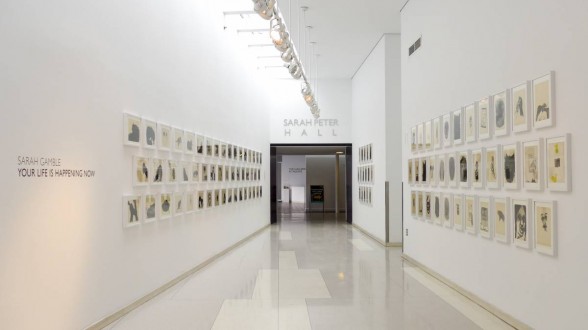
It is easy to be seduced by Gamble’s washed black-and-white tones, reminiscent of those found in some traditional Japanese sumi-e painting. Gamble’s use of the medium to contrast positive and negative fields is striking and impressive. In a good number of her pieces, for example, bottomless white orbs embedded in black faces brilliantly depict eyes peering out into the world.
In fact, there are so many peering eyes in Gamble’s work–whether standing alone, mirrored in handheld compacts, or set in primitive heads of one sort or another–that one almost feels self-conscious walking through the exhibit. And yet this contrasts sharply with Gamble’s preoccupation with masks. We are scrutinized; but there is something that Gamble is holding back.
Although I understand that the artist intended to pair related works and to create a web of interconnected themes, various other motifs seem randomly spread throughout the exhibit. It was clear which works were related, although they were not always paired; but I could not identify the interconnected themes.
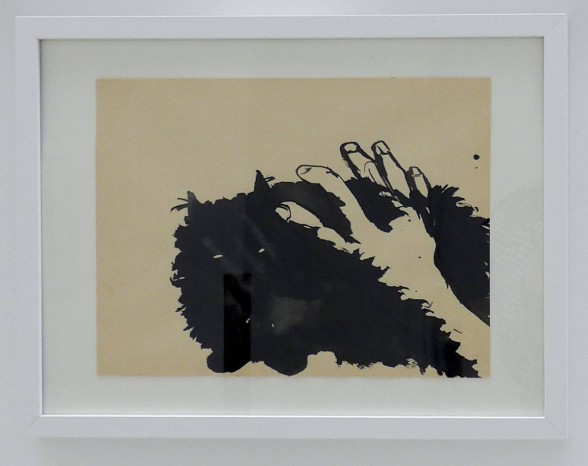
Gamble’s cats dominate the exhibit: multiple, indeed, far too many variations on a sedentary, frizzy-haired black cat. There are also cats bled into owly monsters, which I found more interesting than Gamble’s pedestrian cats. The outlier in the cat group is an engaging piece with an ungainly white hand draped over the animal.
Surprising centaur subset
All of Gamble’s subjects, whether realistic, Expressionist or what have been described as “otherworldly,” are plucked out of their environments, often disembodied, and presented to the viewer on an invisible platter. There are no backgrounds; no contexts. While this was effective in some of the more iconic images presented, in others it lent a sense of incompleteness.
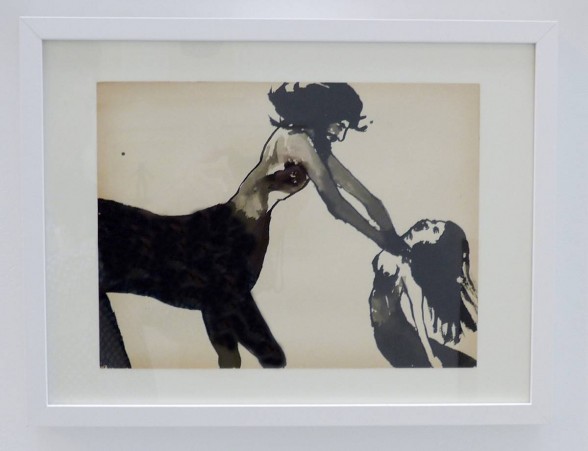
Surprisingly, Gamble presents a centaur motif–something one does not see very often in contemporary art. I found these pieces to be among the strongest and most personal of Gamble’s works. With one notable exception, in which a man’s head peers out from between a supine woman’s legs, they are the only pieces in the exhibit that speak to the powerful and sometimes violent aspects of human emotions and relationships.
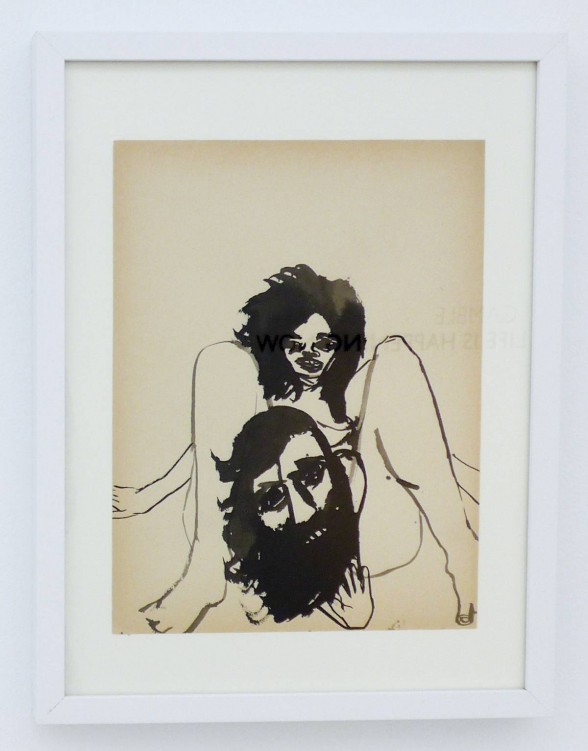
Gamble’s centaur pieces are strong because the emotions they convey are placed in a narrative context. Her obsessions with cats and eyes, by contrast, although powerful, are stripped of narrative context, and I think are less effective as a result.
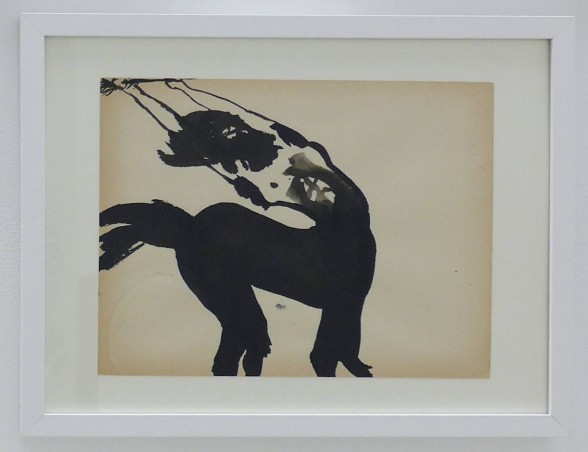
Some standouts and less “serious” pieces
There is also a mouth motif in the exhibit, which I found flat: disembodied, gaping mouths, even one at the dentist. In fact, the mouths generally reminded me of dental impressions, and likewise lacked emotion.
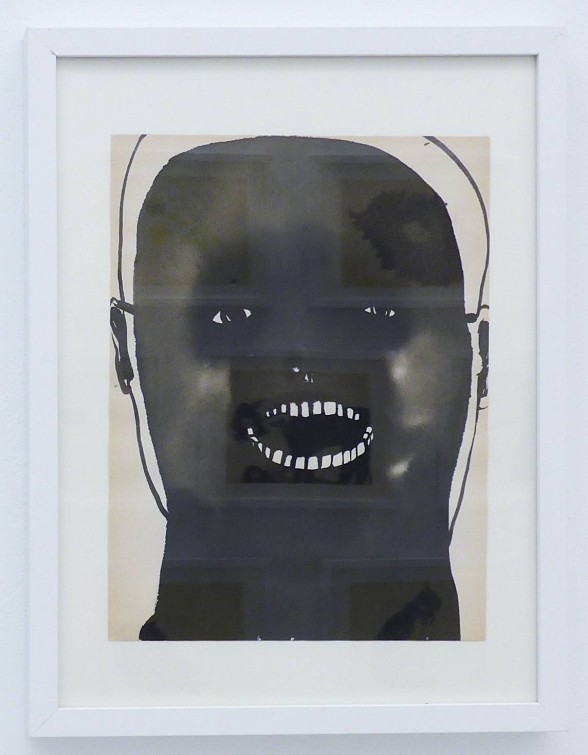
There are a few unremarkable portraits in the exhibit. There are the cat- and dog-monsterish figures, which are not frightening–in fact, even Gamble’s owly cat-monsters fail to invoke our primal feline fears. And there are a series of masked faces and totemic figures–a few of which, such as the black-masked face pictured here, are wonderful and unusual, but many of which seem stereotypical.
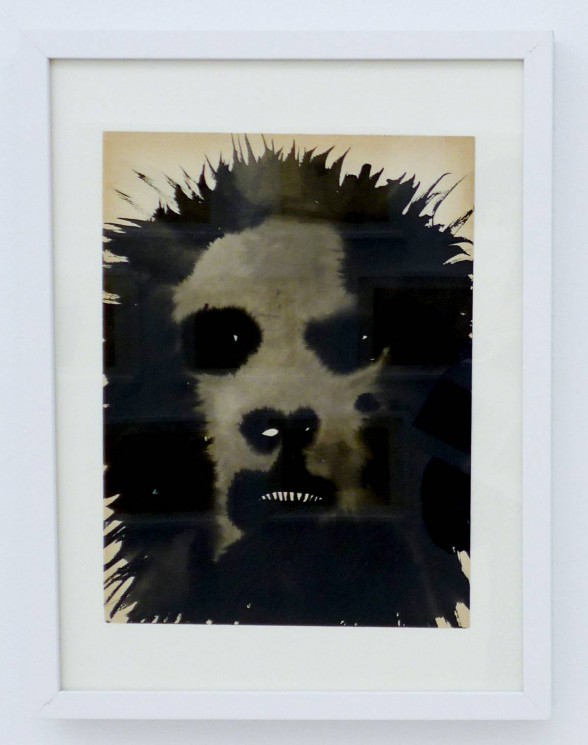
Finally, there are a number of what I will call “text sketches”. Book covers, travel brochures, Gamble’s New Mexico Medicaid card and the like, which are not interesting or appealing on their own, and which do not seem connected, in any way that I could discern, to the exhibit as a whole. I understand that many of the pieces in the exhibition were created during Gamble’s time in the Roswell Artist-in-Residence Program in New Mexico, and the sketches may connect to that excursion, but they do not appear to connect to the artwork, nor is there any obvious connection, perhaps because of the contextlessness of the work, between the artwork presented and Gamble’s experience at Roswell.
I was disappointed by Your Life Is Happening Now in part because I felt that it included too many pieces that were weak or unserious. Perhaps that is inevitable in an exhibition of 100 pieces created in a year’s time. More importantly, I felt that Gamble was holding back something of herself from us: that in some way, she was not taking risks that would have allowed us to get more of a sense of the “life happening” about which she was trying to communicate.
Still, there are a handful of strong, serious pieces in the exhibition that communicate feeling; strike at the essence of their subjects, as one would hope to discover in Sumi works; and reflect the beauty that this medium can capture.
Sarah Gamble: Your Life Is Happening Now is on display at the Galleries at Moore through March 14, 2015.









